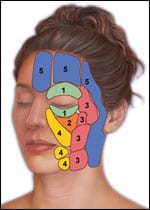 |
| The different facial compartments and the order in which they age, beginning with No 1 under and above the eyes. (Courtesy of the University of Texas Southwestern Medical Center.) |
According to researchers at the University of Texas Southwestern Medical Center in Dallas, previously held theories that facial aging is attributed to ptosis or drooping of the skin and fat due to gravity are being challenged. The researchers have discovered that the face comprises multiple discrete anatomical regions and is unlikely to age as a confluent mass.
“The study looked at the anatomy of the fat on the human body,” says Joel Pessa, MD, assistant professor of plastic surgery at the medical center and the study’s lead author. “What was found was that all of the fat—both superficial and deep—is contained within discrete compartments. This is important for several reasons, but the most important is that we probably gain and lose fat at different rates depending on the compartment.”
Pessa says the face resembles a 3D puzzle, with fat divided into distinct units around the forehead, eyes, cheeks, and mouth. During a facelift, different zones of the face are dissected. According to Pessa, facial aging is, in part, characterized by how separate compartments change as we grow older.
A youthful face is characterized by a smooth transition between these compartments. As people age, contour changes occur between these regions because of volume losses and gains, and repositioning of the compartments. This can eventually result in hollowed skin and sagging.
In the study, Pessa and his colleagues performed 30 cadaver dissections on 18 male and 12 female subjects who ranged in age from 47 to 92 years. The researchers injected different types of dye (letraset, bombay India ink, indocyanine green, and methylene blue) into the nasolabial-fold partitions and let the dye settle for 24 hours to allow tissue diffusion. Methylene blue consistently displayed the best tissue diffusion.
The researchers report that despite the 24-hour settling time, the dye, rather than permeating the entire face, stayed in separate areas, showing that individual facial compartments have boundaries between them that act like fences. The researchers note that the fences comprise fibrous tissue that allow the face to maintain its blood supply in case of injury.
The researchers also injected nasolabial fat in 10 hemifaces from three male and two female cadavers. The faces were allowed to set at least 24 hours. The researchers report that the volume of this compartment did not vary much among the cadavers, regardless of age or sex. Also, the researchers note that medial cheek fat overlapped nasolabial fat to a greater degree in certain cadavers.
Pessa says the most important thing is that we gain and lose fat at different rates depending on the compartment.
“For years, we have thought this resulted from skin and fat falling from the cheek toward the nose. But now we understand that these compartments don’t move that much—fat cannot really move from in front of the ear to the fold at the nose,” Pessa says.
“Understanding how fat is compartmentalized will allow us to be very accurate and precise in how we approach facial rejuvenation,” Pessa continues. “This gives us an algorithm, or scientific approach, to help ascertain what areas of the face may need extra fat to combat the aging process.
“It also is a major breakthrough in facial anatomy that will have major implications for future studies on aging, as well as possibly hold clues to the study of other diseases such as obesity, diabetes, and cancer,” he adds.
What Causes Facial Aging?
The skin begins to age when the body stops growing in late adolescence. However, the effects of aging are not apparent until midlife.
As we age, skin cells replace themselves more slowly and the dermis begins to thin. On the face, elastin and collagen fibers that allow our skin to stretch and retract begin to unravel. The thinner and less elastic skin tends to sag and fold.
According to plastic surgeons, some genetic factors may be attributed to facial aging. Fair-skinned patients, for example, are more susceptible to photoaging caused by sun exposure compared with darker-skinned patients. Prolonged exposure to the sun may also cause the skin to become stretched and leathery. Other factors that speed aging of the face include rapid weight loss and constant stress.
“Environmental factors, smoking, and sun exposure are the two most common, but tooth loss also leads to lack of bone platform to support the soft tissue,” Pessa says. “People who have lost many teeth usually appear older than people with full dentition. This is not generally recognized.”
Unfortunately, the aging process cannot be stopped or reversed; however, good daily skin care can slow the process. Physicians should remind their patients to wash their faces daily with mild soaps containing moisturizers; to avoid prolonged exposure to the sun; to use sunblocks; to eat plenty of grain, fruits, and vegetables; to exercise daily and do facial exercises to retain muscle tone; and to not smoke.
Who Should Get a Facelift?
According to Pessa, the best candidates for facelifts are patients who understand that the science and technology are evolving and those who are happy with their lives overall.
“The technical ability and results may be secondary to how the patient views himself even before surgery,” Pessa says. “Patients who, in general, take good care of their overall health seem to do better postsurgery.”


